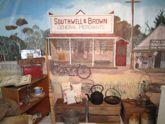Rediscovering Ginninderra:
Ginninderra Convict Barracks
Related People
James Carpenter
James Carpenter was one of the earliest convicts allocated to George Palmer's Ginninderra station....
Richard Coates
Yorkshireman, Richard Coates (also spelled 'Crates' or 'Coots') was assigned to George Palmer...
Caleb Flude
Caleb Flude (also spelled 'Flood' or 'Hude') was one of the earliest convicts at Ginninderra,...
Thomas Gallagher
In the 1828 census, Thomas Gallagher is recorded as a convict shepherd working at Palmer's...
James Gledman
In the 1823-1825 convict muster, James Gledman (listed as Joseph) was recorded as a servant...
John Heley
Twenty-year-old John Heley (sometimes 'Hurley', or 'Haley') arrived aboard the Mangles...
John Jones
Twenty-one year-old John Jones had not been in Ginninderra very long when the 1828 census was...
John Keane
John Keane was only sixteen years of age when he was transported to Australia in 1826 on the...
William King
William King must have been a trusted convict in the eyes of George Palmer, as he had been...
John Lowe
Dubliner, John (sometimes 'James') Lowe, arrived in Australia on the convict transport Regalia...
Duncan McFarlane
Duncan McFarlane was the overseer at Ginninderra for absentee landlord, George Palmer. From...
Joseph Reich
Little is known about Joseph Reich (sometimes spelled 'Rich'), who was one of the early...
John Walker
Ex-marine, John Walker arrived in the colony in 1826 on the convict transport, Countess Harcourt,...
The original labour at Palmerville and other pastoral stations of the Limestone Plains in the late 1820s and throughout the 1830s was provided by convicts.
Palmer sent Duncan McFarlane out as overseer to manage the convict workforce he had deployed at his Ginninderra station to build the infrastructure for the estate and as shepherds and farm workers. One of the earliest buildings constructed by them was the convict barracks itself. In the 1828 census, McFarlane is recorded as having a convict crew of 13 at Ginninderra as well as two recent emancipists (Patrick Conlon and Thomas Hyland).
The barracks were in ruins by the turn of the century as the photographic record shows. It was not long before the remaining stonework and hand-made convict bricks of the Palmerville buildings were robbed out, with some even turning up in a feature wall of a Manuka architect's house in the early 1970s.
Related Photos
Click on the caption (⧉) to view photo details and attribution.
References
- Gillespie, L. L., Ginninderra: Forerunner to Canberra, Campbell, 1992
- Meyers D. (ed. K. Frawley), Lairds, Lags and Larrikins: an Early History of the Limestone Plains, Pearce, 2010
- 1828 Census and convict transportation records
- Information from Nell McDonald (nee Curran), resident of the Palmerville cottage (1922-1927)
< Rediscovering Ginninderra


